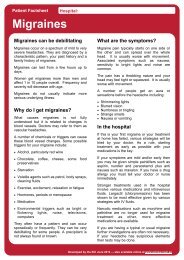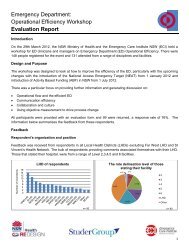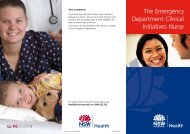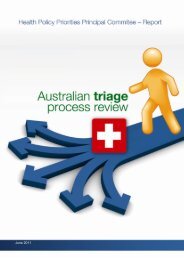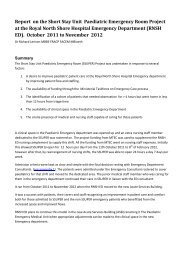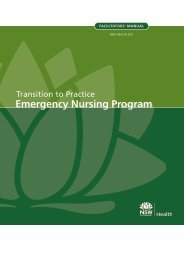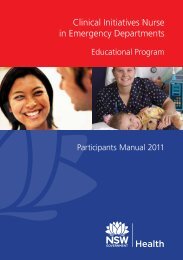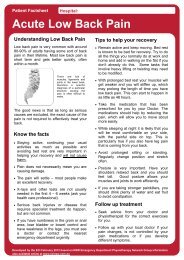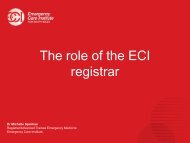Emergency Department Models of Care 2012 - NSW Health
Emergency Department Models of Care 2012 - NSW Health
Emergency Department Models of Care 2012 - NSW Health
- No tags were found...
You also want an ePaper? Increase the reach of your titles
YUMPU automatically turns print PDFs into web optimized ePapers that Google loves.
Challenges ■ Implementing the ED SAS without having in place supporting models <strong>of</strong> care and/or thephysical space for it. This includes a quick triage, ETZ and Fast Track area.■■■■Changing the process <strong>of</strong> how patients are assessed and streamed, i.e. a senior decisionmakersees a patient directly after triage and determines a provisional diagnosis within 10minutes, then streams the patient to the next MOC.Determining the staffing arrangements for when the model is flexed up and down.Ensuring that there are sufficient senior medical and nursing staff in the ED staff pr<strong>of</strong>ile tooperate the model.To have only one-way directional patient flow – many EDs currently refer patients backinto the waiting room while awaiting test results and disposition decisions, due toestablished practices or a lack <strong>of</strong> alternative space.Case for implementationWhat you need to runthe modelTo assess the need for implementation <strong>of</strong> this model in your ED, consider the following:■Does your ED experience inefficient patient flows?■ Is your ED meeting waiting time to treatment targets (especially in categories 3–5)?■ What is the average length <strong>of</strong> stay for patients in the ED (especially in categories 3–5)?■■■■Staff■■■What proportion <strong>of</strong> patients in your ED did not wait for assessment and treatment?Is your ED meeting National <strong>Emergency</strong> Access Targets (4 hour targets)?Is your ED meeting transfer <strong>of</strong> care times?Does your ED experience bottlenecks at triage?It is essential that the model includes an in-charge senior ED Medical Officer, preferablyan ED Staff Specialist, senior Registrar or senior CMO. Without a senior decision-makerthe MOC cannot function effectively.An assistant medical <strong>of</strong>ficer, for example a Junior Registrar/CMO/RMO, will be used tocomplete documentation/ brief assessment, order investigations, commence treatmentand review results.Nursing staff will be assigned defined roles and responsibilities. This will include aStreaming Coordinator to facilitate the flow <strong>of</strong> patients from triage into and through theMOC and to nurses in the streaming and early treatment zones.Physical spaceThe physical requirements will depend on the volume <strong>of</strong> patients likely to be managed in thearea, and the procedures that drive practice and the maintenance <strong>of</strong> effective flow.Consider:■■■■The proximity to key diagnostic and treatment services such as radiology and plaster roomThe number <strong>of</strong> treatment spaces needed to optimise the use <strong>of</strong> the MOCThe need for specific treatment equipment for minor proceduresWorkspace and write-up areas for clinicians.Business rules■■■Develop business rules that facilitate the MOC processes in the ED, for example, operatinghours and staffing skill mix.Ensure flow through the MOC is constant. This role is undertaken by the streamingcoordinator.Ensure strong management and adherence to operational policies.PAGE 26 <strong>NSW</strong> HEALTH <strong>Models</strong> <strong>of</strong> <strong>Emergency</strong> <strong>Care</strong>




